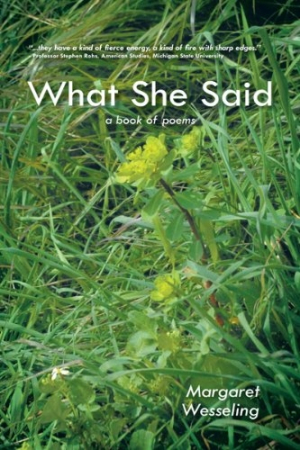What She Said
A Book of Poems
Arresting stream-of-consciousness poems reflect on the frailty and beauty of life.
With striking images, invented words, and judicious use of repetition, the poems in Margaret Wesseling’s new collection, What She Said, strike a careful balance between fear and cynicism on one hand, and unity and joy on the other. Themes range from memory and the author’s Dutch background to essential human vulnerability. Throughout, the author’s skillful use of language and sound makes for extraordinary reading.
The book opens with the excellent “Self,” a sobering meditation on fragility and possibility. “Frail bone lodge bound with blood // …We will be light / to light one day, flesh to dust. / … / Stage by stage we drag [the body] after us / and who knows / what we will do.” By repeating words and phrases, Wesseling crafts a hypnotic lullaby rhythm, as in the last lines of “Heron”: “Shhh, darling, is what is. / Is what is, darling, is what is.” Another beautiful example of repetition appears in “One would like to think,” where Wesseling fosters a compelling image of harmony: “See how it fits together / how everything fits together / right, like something made / to fit together.”
Many poems end mid phrase, without punctuation, mimicking the ongoing process of thought. A stream-of-consciousness approach manifests itself in the omission of linking words (“clocks / homework / each day same” in “Barracks Life”) and occasional contradictions (“you were with me you were not with me” from “Jumping off the cliff last time”). Emulating Joyce or Shakespeare, Wesseling also tries her hand at creating neologisms, on occasion forming her own compound words, like “boatbottom” and “lowfloating” in “A boat ride in Friesland.” The author’s time spent in the Netherlands is on display in this poem and several others, including “Van Gogh” and “Dear D—,” structured as a letter reflecting on her origins, and “hi hi hi,” where the Dutch language makes a surprising incursion in two stanzas.
The poems eschew end rhyming in favor of understated internal half-rhymes and alliteration. “A boat ride in Friesland” creates a soft, lazy atmosphere through recurring L and S sounds as well as through appropriate vocabulary: “The sailrope, slack, flaps / … / the stillness of this air this day / that folds our sluggish moves / in amber.” Wesseling’s metaphors feel consistently fresh, such as “the sun like a drunk’s / eye” (“Little”), “our voices / inefficient twitterings” (“Nothing”), and “all human mouths are red / trumpets for pain” (“Chinese rose outside my window”).
The poetry is less successful when the author takes on social issues like homelessness or abortion. Still, even in more politically minded verse, she recognizes the importance of neutrality: “Try / to be nothing / in the middle of action” is the seemingly oxymoronic message of “How to change things.” Moreover, “Prayer” is a playful refutation of traditional concepts of the deity: “God, bully, extortionist / … / mismanager of the funds of the universe.”
All through these poems, Wesseling exposes the difficulty of true communication and the irrational workings of recall: “is it always straight? / Never moving, like I think / it must be” (in “Memory”). Reading this poetry requires relinquishing some basic rules of language and surrendering to the author’s innovative rhythms. It is a liberating experience, especially recommended for those who enjoy Virginia Woolf and Gerbrand Bakker.
Reviewed by
Rebecca Foster
Disclosure: This article is not an endorsement, but a review. The publisher of this book provided free copies of the book and paid a small fee to have their book reviewed by a professional reviewer. Foreword Reviews and Clarion Reviews make no guarantee that the publisher will receive a positive review. Foreword Magazine, Inc. is disclosing this in accordance with the Federal Trade Commission’s 16 CFR, Part 255.

